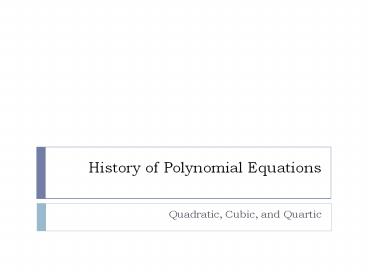History of Polynomial Equations - PowerPoint PPT Presentation
Title:
History of Polynomial Equations
Description:
... Early Polynomials Arab and Indian Mathematicians Dominated during period between Greek ... An extension K/k is a radical extension if there is a tower of ... – PowerPoint PPT presentation
Number of Views:193
Avg rating:3.0/5.0
Title: History of Polynomial Equations
1
History of Polynomial Equations
- Quadratic, Cubic, and Quartic
2
Contents
- History
- Early Polynomials
- Cubic
- Quartic
- Quadratic
- Completing the Square
- Reduced Polynomial
- Cubic
- Quartic
- Radical Extensions
3
Early Polynomials
- First seen in Mesopotamia, during Babylonian
period - Solved verbally
- Systems of linear equations used
- Egypt
- Ahmes Papyrus
- Recorded by scribe Ahmes around 1650 BC
- Contains 87 problems and solutions
- Practical problems
- Math exercises
- Asia
- Nine Chapters on Mathematical Art
4
Early Polynomials
- Greece
- Only concerned with positive solutions
- The Elements, Euclid
- Foundation of geometry, brief mention of
geometric solution to quadratic equation - Arithmetica, Diophantus
- Based on theory of numbers
- Could solve
5
Early Polynomials
- Arab and Indian Mathematicians
- Dominated during period between Greek mathematics
and rebirth of math in Europe - Muhammad ibn Musa al-Khwarizmi
- Kitab al-jabr wa al-mugabalah origin of the term
algebra - First occurrence of general quadratic equation
- Europe, 12th century
- Hibbur ha-meshihah ve-ha-tishboret (Treatise on
Measurement and Calculation), Abraham bar Hiyya
Ha-nasi
6
Cubic
- No solution found until 16th century
- Scipione del Ferro, found solution to x3mx n
but did not publish - At his death passed to student, Antonio Maria
Fior - Fior challenges Niccolo Fontana Tartaglia to
contest - Each proposed 30 problems
- Tartaglia finishes within 2 hours, Fior completed
zero problems - Tartaglia had discovered the solution only days
earlier
7
Cubic
- Giralamo Cardano and Tartaglia
- Cardano contacted Tartaglia for the solution to
put in his book - Tartaglia refused initially, but eventually gives
Cardano the solution - With the solution to x3mx n , Cardano is able
to find proof and begin working on more general
solution
8
Cubic and Quartic Solutions
- Cardano and Ludovico Ferrari
- Ferrari was student of Cardano
- Discovered solution to quartic at the time
Cardano found cubic - Results published in Ars Magna (1545)
- First time solutions are seen to be negative,
irrational, and involve square roots of negative
numbers
9
Completing the Square
Adding and subtracting the area of the smallest
square gives,
Assuming z is a root of the equation,
10
Reduced polynomial
- Definition (1) A polynomial f(x) of degree n is
reduced if it has no terms - Lemma (1) The substitution of
changes
where or into a
reduced polynomial . If
u is a root of , then is a
root of .
11
Quadratic (Reduced polynomial method)
- Let with
. - Then, and the
roots are - and the roots for
are
(1)
12
Corollary/Theorem
- Corollary (2) Given numbers c and d, there
exists numbers a and ß with a ß c amd aß
d. - Theorem (3) If f(x) of kx were k is a
field then a k is a root if and only if x-a
divides f(x) in kx.
13
Cubic
- Cardanos trick was to write the root u as aß
u. Then substituting into the equation,
using Corollary (2) , which
forces the u term to drop out and we arrive at,
We can rewrite this as,
(2)
(3)
(4)
14
Cubic (continued)
- Since Eq (4) is a quadratic in a3 it and can be
solved using the quadratic formula.Taking the
cube roots of a and ß, we find are able to find
one root of the equation by substitution.
(4)
(5)
15
Cubic (continued)
- Then using Theorem (3), dividing f(x) with (x-u)
we arrive at a quadratic g(x) which can be solved
with the quadratic formula to find the remaining
two roots.
(6)
16
Quartic
- Similar to quadratic method using a reduced
polynomial Substitue and
then factor into
quadratics,
(7)
(8)
17
Quartic (continued)
- To find j,m, and l combine like terms and set the
coefficients equal,you arrive at,which is a
cubic in j2. Then use the cubic equation already
found to solve for m and l. Subsitute j, m and l
to find the four roots using the quadratic
equation.
(9)
(10)
18
Pure Extensions
- Definition (4) A pure extension of type m is an
extension k(u)/k where um k for some m1. An
extension K/k is a radical extension if there is
a tower of fields, where each Ki1/Ki is a
pure extension of type mi.
19
The Quadratic as a Radical Extension
- For the equation
, let where . Then
by definition K1 is a radical extension of
since u2 . - So, by Definition (4), f(x) is solvable by
radicals.
20
Conclusion
- The Equation That Couldnt Be Solved by Mario
Livio































